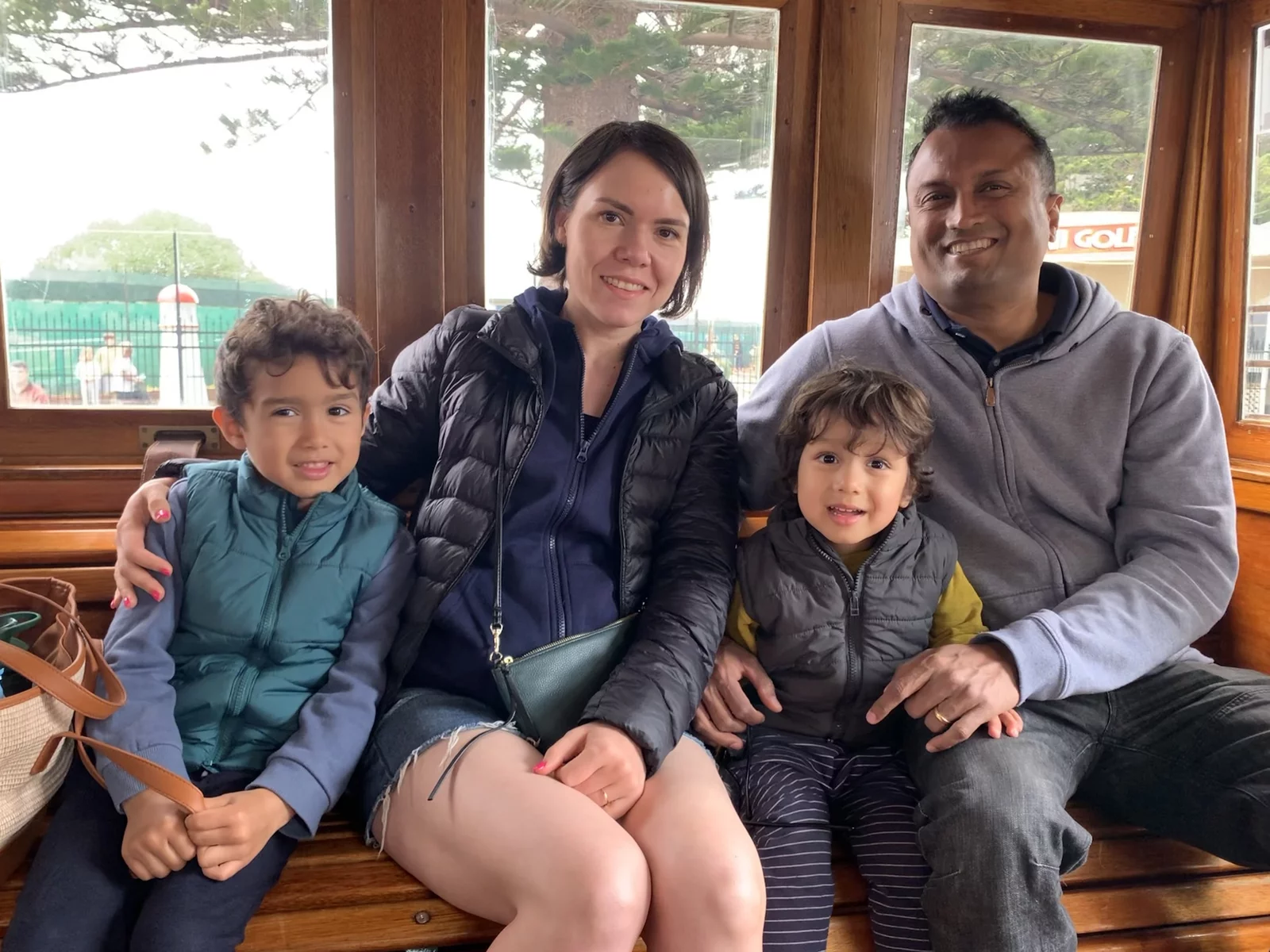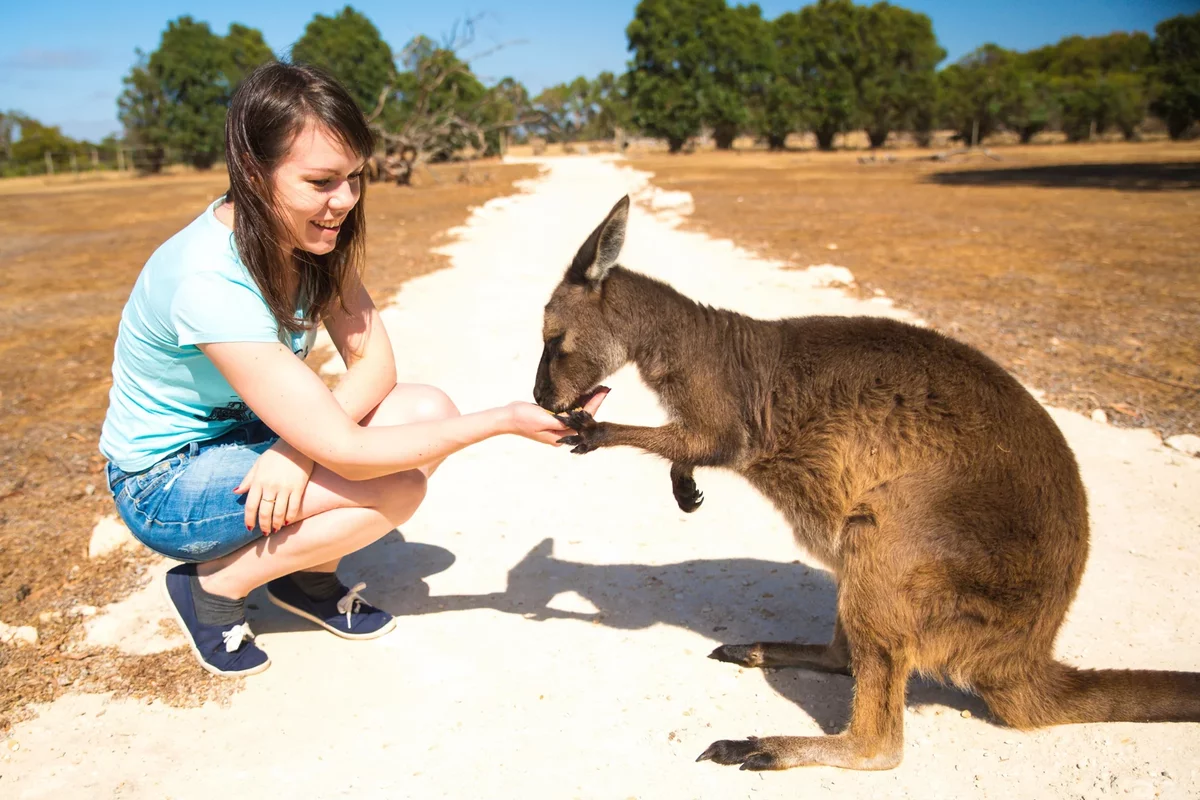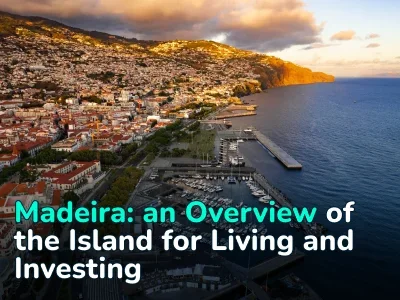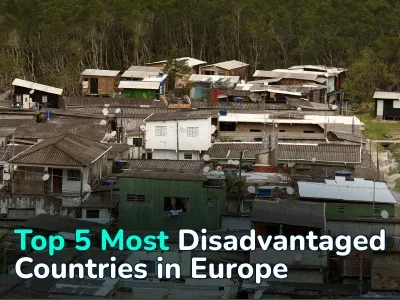
Interview About Life in Melbourne: From Culture Shock to University Admission
Today, we will get acquainted with the story of Yuliya Perera, a Russian woman who found her home on the other side of the world, in Australia. She shared with us her experience of adapting to Australian culture, talked about the nuances of entering a local university, and revealed the peculiarities of life in Melbourne — from cold houses in winter to the absence of stray animals on the streets.
If you have money, it is not so difficult to come and legalize in Australia.
Moving to Australia on a Wife Visa
— My name is Yulia, and I am 37 years old. I'm currently studying to become a nurse at an Australian university. I have two children — two boys (7 years old and 4 years old). I am married to an Australian who is originally from Sri Lanka. We have been living in Melbourne for the last 8 years.
Before meeting my future husband, I lived in Japan for 5 years and worked as a sales manager in a company that exported cars all over the world.
If you have money, it is not so difficult to come and legalize in Australia. It is also desirable that your profession is in demand in this country. And knowledge of English, of course, is also required.
True, for most immigration programs, there is an age limit, which is 45–49 years. The exception is investor visas, where age does not play a role. Also, parents of Australian citizens can immigrate regardless of age.
It is best to assess the chances of moving with a migration agent, as everyone's situation is different.
I moved to Australia on a wife’s visa, and at the same time I received a residence permit. And after two years, I was given citizenship. Therefore, everything was relatively simple for me.

Admission to an Australian university and studying features
— After the birth of my second child, I thought about what I wanted to do when the children went to school. When my eldest son grew up, I decided to enroll as a nurse at a local university. The reason was that I had the opportunity to observe the work of nurses during the 5 days that I spent in the hospital with my son. Subsequently, I also wanted to master this profession.
What my admission process looked like:
- I started preparing somewhere in mid-May. Acceptance of applications began in August.
- In June, I passed the mandatory English language exam and received the required score.
- It turned out that you can immediately enroll in the second year on the basis of your existing higher education. Therefore, I translated my Russian diploma from 2014 and my school certificate. And of course, I attached my Australian passport (a citizenship certificate is also suitable) — this helps save on education.
- In addition, it was necessary to complete a course in anatomy and physiology lasting 3 months. I finished it around October.
- While I was finishing the course, I submitted an application to the university in August, indicating by what time the course would be completed.
- Having completed the anatomy and physiology course, I attached a certificate from both universities and began to wait for the results.
The first results came around November — I was accepted into a two-year course at La Trobe University. A month later, I received a notification of acceptance to another university, but it was too far away, so I chose the first option. Thus, having submitted my application in August, I already received notification of admission in November. Classes began in February 2023.
It is important to note that application submission dates may vary greatly from university to university. There are options when admission opens every three months, with the possibility of starting training in June, October, and so on.
In general, the typical higher education course in Australia is 3 years; sometimes 4 years, if we are talking about obtaining a double specialty: for example, at my university, those who enrolled in nurse-midwives study for that long.


— Now I’ll tell you directly about the studying process.
Since COVID-19, most classes and lectures at Australian universities have continued to be conducted online. Every student has access to a platform where all the information about the required subjects is available. Each module contains lectures, training, and additional materials, as well as links to them.
After each module, you have to take tests, also online. In addition, for each subject, you need to write written works and essays. And then there are exams, during which the knowledge gained in practice is assessed.
For each module, we have one workshop, for which you need to come to the university in person. There, classes are structured as follows: we are divided into groups, the lecturer gives us a topic, then asks each group a question about it, and at the end we discuss it all together. In addition, there are also laboratory classes where we practice clinical skills (how to take blood from a vein, place an IV, give injections, etc.).
In one or two subjects per semester, we have practice, without which the entire subject is not counted. At first, it lasts 2–3 weeks, and in the last semester, it lasts 6 weeks. As a rule, the practice takes place in a hospital, and special clinical teachers are next to the students all this time, evaluating their skills and suggesting everything that is necessary.


— As for the cost of training, I can only talk about my experience and my university. My pay is AUD 7,000 per year (~USD 4,650) since I am a citizen.
If a foreigner comes on a student visa, then the cost already increases to 26,000 AUD (~17,266 USD) per semester — a girl from my university shared this information with me. And she, already in Australia, applied for a scholarship. She was given AUD 13,000, which covered half of her tuition. Of course, no one can guarantee receiving a scholarship, but, in principle, it is possible.
I personally got involved in the program that was promoted by the now former prime minister as part of his election campaign. Then he promised to make education for nurses free. He was chosen, and education became conditionally free for those entering the 2023–2024 academic year.
I got into this program because I started my studies in 2023, and as part of this, at the end of each academic year, 3000 AUD (~2000 USD) comes to my card. And if I work in a public hospital for 2 years after graduation, I will be paid another 7,000 Australian dollars.
When I first arrived in Melbourne, I was struck by the lack of people on the streets.
First Impressions and Comparison with Japan
— At first, it was very difficult for me to get used to life in Australia, because the rhythm of life here and in Japan is completely different. In the latter, life is in full swing: there are a lot of people around, bars and karaoke are full at the end of the day, and parties are constantly held.
And when you come to Australia, you feel like you’re in a big village: many establishments and shops close early, there are few passers-by (especially in residential areas), and there is silence all around. And at first, it really depressed me. But over time, I got used to it, especially when children were born. Raising children here is much more comfortable.
The big difference is also that in Japan, you will never become one of the locals, no matter how long you live there or how perfectly you know their language. It has often happened to me when I spoke to them in perfect Japanese, but they still answered in broken English — this is their automatic reaction when they see a foreigner. Moreover, not long ago in Japan, foreigners were issued ID cards called alien cards. This probably says a lot.
In Australia, the situation is completely different: a huge number of nationalities live here, on the street you can immediately meet an Arab, an Indian, and a dark-skinned person — this is absolutely normal and familiar. That's why everyone here accepts each other.
Moreover, this acceptance of all cultures is given great attention at the state level: there are days when events are held in schools and concert halls, when everyone can come in their national costume and talk about their country and culture. Even at our university, we had a subject in which we studied how important it is to respect other cultures and treat all people equally. I consider all this a big plus of living here.


— Also striking is the availability of food in Japanese restaurants and the opposite situation in Australian establishments. This is especially true for lunch, during which good Japanese restaurants offer decent discounts — you can have a hearty meal for $10. In stores in Japan, you can also always buy ready-made fresh food for less than $10.
In Australia, food costs much more: at the most budget restaurant, pasta will cost approximately $23. At the same time, the portions here are very large, and the food itself is very heavy — often it is not accompanied by vegetables or salad at all. Therefore, I prefer to eat at home, except that sometimes I go to coffee shops.
And another important point: in Australia, it is very difficult to live without a car, since transport is not as well-developed as in Japan. The latter's metro lines even reach remote towns and villages, and you can travel between cities by high-speed trains. And in Tokyo and Okigawa – I lived in these two cities – you can quickly get from point to point, even with transfers. Transport runs frequently and on an hourly basis.
In Australia, there are nuances to this: you have to wait for a bus from 20 to 40 minutes. Things are better in the center, but it’s still more convenient to get around by car. Therefore, it is in almost every family.

Features of Australia that amazed me
— When I first arrived in Melbourne, I was struck by the lack of people on the streets. It even made me a little depressed. The fact is that in the city center people mostly only study and work, and live in residential areas around Melbourne. And here almost everyone moves by car, so there is practically no one on the streets. After Japan, this feeling of desolation was especially unusual.
Another feature that I still find difficult to get used to is the lack of central heating in the apartments. In winter in Melbourne, the temperature outside is about +13 degrees, and indoors in the morning it can be +15-17 °C; It's even colder in older houses. There is gas heating — special devices in the ceiling from which warm air blows. But using such heating leads to high gas bills. I remember we got about 400 local dollars for 3 months. So we installed solar panels and now use air conditioning in the living room instead of a gas heater.
Due to the cold, even at temperatures of 20-21 °C in winter, the floors remain cold. I walk around the house in boots and a sweatshirt, but it’s still cool. It turns out that you have to wear warm clothes at home for almost 6 months of the year.
By the way, I was surprised that according to the law in Australia, you cannot change light bulbs in your house yourself, you must call an electrician. Apparently, there were some incidents on this basis in the past.
The quality of cafés and restaurants in terms of atmosphere often leaves much to be desired. Especially not in the center. Even with delicious food, the place can be dirty. The restaurant may look like an ordinary café. Fast food establishments such as McDonald's are rarely clean. Of course, there are beautiful places, but in residential areas, the quality is mostly average. Most often, complaints arise specifically about the interior and furnishings.
I compare it with Russia, although I haven’t lived there for a long time. If it is customary there to dress up to go to a restaurant, then here people calmly come in shorts, T-shirts and flip-flops.
And there are no stray dogs or cats in Australia. All animals are microchipped and have owners. If you see a dog alone on the street, it is most likely lost. In this case, you need to call a special service that will pick up the animal and find the owner using the chip.

Life with children in Australia
— Living with children here is very comfortable. Firstly, there are few people here, and secondly, there are many opportunities and appropriate infrastructure. This is due to the fact that there are many families here, including large families (up to 5 children in a family is not uncommon here). There are many playgroups and centers in every area. And of course, kindergartens and schools.
The only negative is that kindergartens are very expensive. Our kindergarten costs 145 AUD per day (96 USD), but thanks to the subsidy, we only pay 58 local dollars. Families who cannot afford kindergarten have a hard time.
An important point: they take vaccinations seriously here. They are allowed to go to school without them, but not to three-year and four-year state kindergartens.
I like that the government helps families well. Help is provided to single mothers. If there is a person in the family with mental or physical disabilities, the state can provide a free assistant. They also support those who want to leave a family where there is violence. The social support system is very developed here.
Leisure and Travel in Australia
— For leisure, my family and I try to go somewhere. If we take a vacation, we like to travel around Australia, stay in different cities, and rent accommodation. We can just rent a house for a few days and explore the surrounding area. Now that I'm studying, I often spend my weekends in the library. It takes us more than an hour to get to the sea, so we rarely go there, especially in winter.
Around Melbourne, in our state of Victoria, there are many attractions that can be reached by car. Beautiful nature and famous places like the Great Ocean Road and the 12 Apostles. There are interesting small towns around Melbourne that we go to sometimes too.
You can stay on farms and rent a house there. Typically, farmers live and work in one part and rent out the other. It is very interesting to stay in such places with children.
There are zoo reserves around our state and beyond where you can come to feed kangaroos and take pictures.
Finding your first job in Australia is not easy.
Salaries, Taxes and Real Estate in Australia
— I like that the standard of living here is quite high. Good salaries allow you to live without having to live from penny to penny.
The average salary for a full-time adult is AUD 98,000 per year before taxes (~USD 65,300). But everything greatly depends on the specialty: IT specialists earn a lot, but kindergarten teachers earn not much (55-60 thousand Australian dollars per year). Nurses initially earn 80,000 AUD per year (~53,300 USD). Work experience and additional education allow you to earn more.
Overall, to live comfortably in Australia, I think one adult needs 80,000-90,000 AUD (~53,300-60,000 USD) per year before taxes. In this case, you can go to a restaurant once a week or order food, save for travel, travel somewhere with your family every year, pay your mortgage, and so on.
Finding your first job in Australia is not easy. Some are looking for 1–2 years. The difficulty is that Australians look at work experience specifically in their country. Even if, for example, you have experience as a manager in a large Russian company and good English, it will be difficult to get a job with the same specialty here. Once you gain local experience, even in a different field, you will be more likely to be hired.
In-demand professions in Australia: nurses, design managers (working on construction sites), civil engineers, kindergarten teachers, business analysts, programmers, electricians, cooks, and social workers. Blue-collar jobs, by the way, are very well paid here.
Tax in Australia is progressive: the more you earn, the higher the tax. If you earn less than AUD 18,200 per year (USD 12,130), there will be no tax. It is further distributed as follows:
- For salaries between AUD 18,000 and AUD 45,000: 19 cents for every dollar over AUD 18,200.
- AUD 45,001–120,000: 5092 plus 32.5 cents on every dollar over 45,000.
- AUD 120,001–180,000: 29,467 plus 37 cents on every dollar over 120,000.
- 180,001 and above: $51,667 plus 45 cents on every dollar over 180,000.

— Our family with two children spends $250 a week on groceries; this is the average. It was cheaper before the pandemic — about $150 — but prices have increased dramatically since COVID-19.
Basic food prices in Australia: milk costs 1.60 AUD, 12 eggs cost 5 AUD, and bread — 2.90 AUD.
As for real estate prices, I can say that in Sydney, for example, it is very difficult to buy your own home. Most of the real estate has already been purchased and is being rented out. You can find your own housing only on the outskirts, and that’s not a fact.
When it comes to buying a home in Melbourne, it is still possible. Closer to the center, prices start at 2,000,000 Australian dollars (~1,330,000 USD) per house.
We bought a house in a residential area that was just starting to be built for AUD 350,000. Now it costs more because, since the area has developed well, there is a lot of infrastructure around: kindergartens, schools, shops. When we arrived, the area was empty. In such areas under construction, which are located further from the center (we need 40 minutes to get there by train or car), housing will cost less.
You can rent decent housing in Melbourne for around 250–350 local dollars (166–233 USD) per week. We are talking about renting one bedroom in an apartment or house. The kitchen will be shared, and the toilet will be either shared or private.
A lot of people from Melbourne have moved to Brisbane since the pandemic. I heard that housing there is not as affordable as it used to be. The prices are almost the same.
A significant disadvantage is Australia’s remoteness from other countries.
Pros and Cons of Living in Australia
Let me summarize the main advantages and disadvantages of living in Australia.
Pros:
- High standard of living and good salaries.
- Developed social support system for families, single mothers, and those in need.
- A multicultural society where everyone accepts each other.
- Comfortable conditions for living with children.
- Safety. Of course, there are disadvantaged areas where you can encounter robberies, car thefts, etc. I did an internship at a hospital in one of these, and they even had an escort service: if you park on the street and not in the hospital parking lot, security can escort you to your car. But most areas are fine.
- Beautiful nature and many attractions for travel.
- Open and friendly locals. They can strike up a conversation in a shopping center or in line and give a compliment. Everyone is smiling and pleasant. Such “small talks” are already part of the culture in this country.
Cons:
- Distance from other countries. What I don’t like is Australia’s remoteness from other countries, including Russia. To go to my hometown of Khabarovsk, you need to spend a lot of time: the flight through Dubai takes 40 hours with several transfers.
- Lack of central heating in houses.
- The high cost of kindergartens.
- Expensive real estate.
- Difficulties in finding a first job for immigrants.
- High prices for sending parcels abroad. For example, sending a small parcel weighing 500 grams to Kazakhstan will cost 40 AUD (26.5 USD).
- The need to have a car.
- The superficiality of communication is the other side of those same tar currents. When locals ask how you are doing, they don't want to hear about your problems. That is, no one here strives for deep conversations.
Tips for Those Planning a Move
— Some advice for those planning to move to Australia:
- Eat your fill of cheesecakes, cottage cheese, and dumplings, because it’s not always easy to find them here, especially in small, remote towns.
- Bring all your diplomas and even your children's medical records.
- Bring children's tights if necessary, as they cannot be found here. They only wear leggings with open toes.
- Bring warm clothes and wool socks because, in winter, you will have to dress warmly in Melbourne houses.
- Bring good shoes. Here, it is often of poor quality, and a good one is very expensive. By the way, don’t take a lot of shoes with heels; they are almost never worn here. They prefer practical shoes and sneakers.
And yes, save up more money before moving.


Do you want to share your personal experience of relocating and living in another country? Email us at info@realting.com. We will be happy to tell your story.
Author
I am responsible for editorial work. I write expert interviews and guides.

























